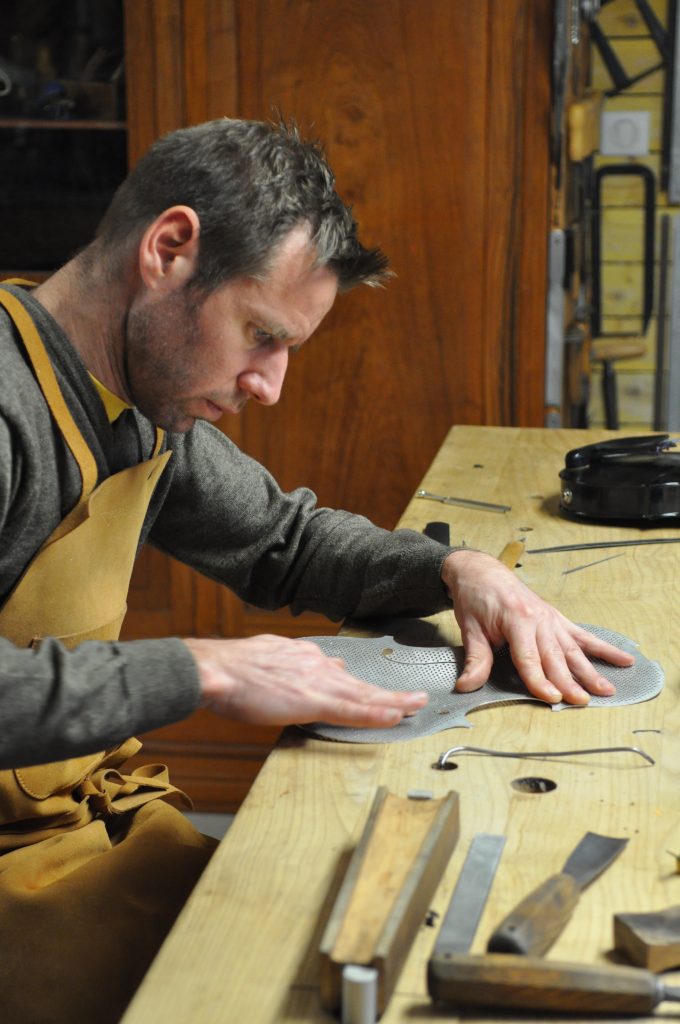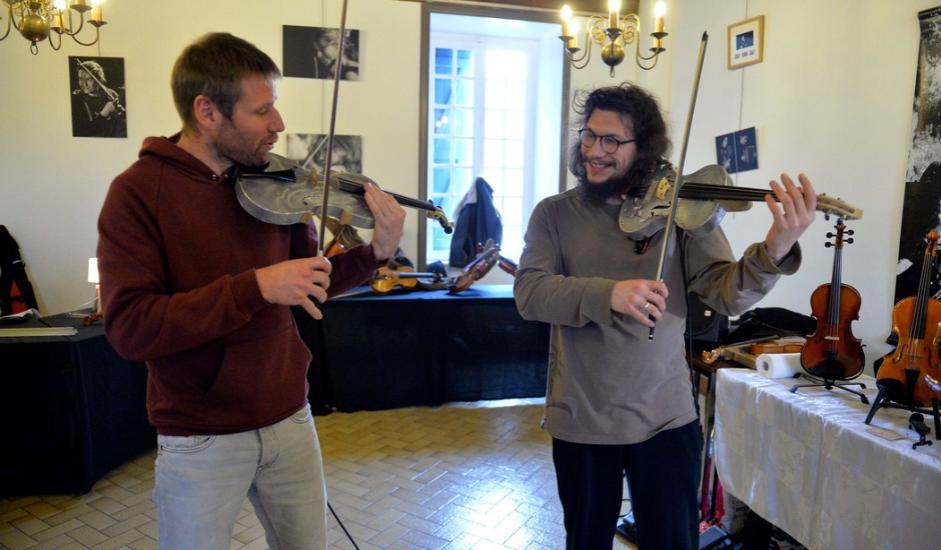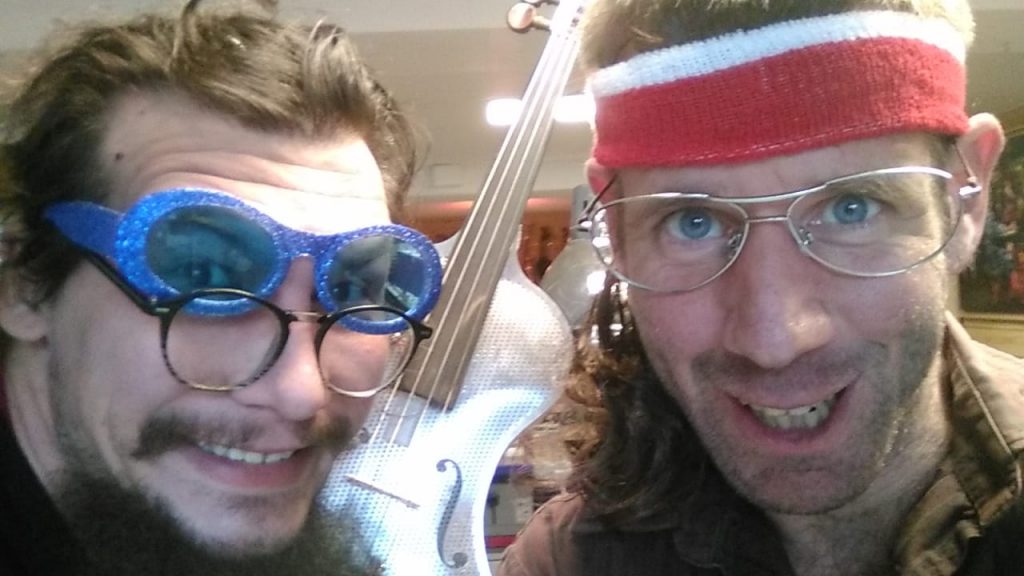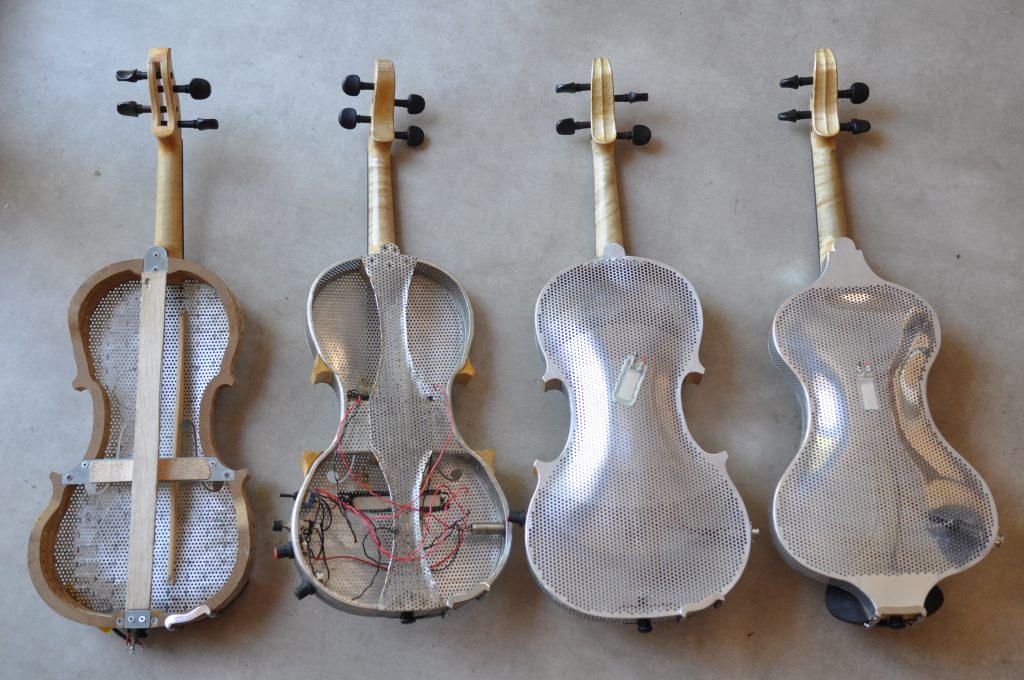Foreword: Unfortunately, Aurélien has left the project, albeit regretfully. The 2020-2022 health crisis with its economic slowdown, combined with our acknowledged incompetence in marketing, have put an end to the possibility – and subsequently to his desire – of making the design and manufacturing of the electric violin Electrolin – previously known as “Zef” – his livelihood.
That is why, out of friendship and respect for Aurélien’s work, you can still find his bio here. Since the name “Zef” went away with him, I chose the name “Electrolin” to bring the electric instrument I manufacture closer to the electro-acoustic range of “Neolins”.

CV Aurélien Bertrand
Everything started with a minor pentatonic blues scale played at age fourteen on my viola.
That was how I fell in love with the Blues, which I had already been listening to from my early childhood on my parent’s hi-fi system. With time, I also discovered the popular music styles that descended from the Blues: Rock, Soul, Funk and Hip-hop.
This first experience of improvisation on the viola, with music which is rarely (never ?) taught to bowed string players in classical music education, has largely influenced the way I play, my hearing and in consequence my ideas concerning what is possible on bowed instruments, ever since.
As I did not attend a conservatory, I could not attend a special music-centered high school. So I pivoted to my other passion.
In 2008, I got a degree as a sound engineer in Saint Denis, a training which taught me a lot about acoustic and electric sound phenomena, and sensitized me to the mixing and diffusion of musical works.
Subsequently, I caught the stage bug, and went on to study at a theatre school in Asnières-sur-Seine, for four years. There I learned to enjoy the present, to find inspiration to create in every moment, to invent, to enlarge my understanding of the world – for this is what acting is about.
But the bowed strings were still on my mind, the warm sound of the viola, and I started playing again. Blues first, and then its «children », exploring new ways to play with a bow. I realized that I needed to acquire the technical grounding which I lacked.
From 2012 to 2014, I went back to taking viola classes at the conservatory of the 9th arrondissement in Paris. Those two years were intense and my technique progressed steadily.
Having acquired an astonishing electro-acoustic instrument, the Neola, from Bodo, I indulged my taste and desire for popular music.
But I was soon faced with the evidence that I would never earn my living that way: Either I would have to play amplified and struggle with feedback, or I would have to settle for a solid-body sound closer to a mosquito than a violin or viola. Or, I could decide not to play amplified at all, but that’s not really an option in popular music! That would mean forgetting about all possible sound effects, and the exaltation of playing at 110 dB and take myself for a guitar hero!
Finally, as I do have to earn a living, I turned back to an old passion of mine: navigation. I joined the National Merchant Navy School in Marseille in 2014. If everything worked out as planned, I could end up as an officer in the merchant navy, living a peaceful and exciting life, and never worry again about how to fill my fridge.
But at the back of my mind there was also the secret hope that, I could sufficiently enrich my mathematical and electronic knowledge to maybe, one day, find a solution to create electric violins which sound like real violins. To get the same richness of expression out of an electric instrument.
Everything worked out just fine. I earned some solid knowledge in the mathematic and electronic domain.
Even more important, the encounters I made helped me grow and take pride in being part of the community of seafarers.
Two years into my training, after two and a half months of uninterrupted navigation during summer, I felt a strong urge to play music again. So I planned to use my autumn vacation to play the viola and further explore end enlarge my popular music repertoire.
But less than a week before the vacation, I broke my left wrist !
Alone in my shared flat, in the cold mistral winds, with an aching and immobilized wrist, incapable of playing the viola or even writing, unable to take a shower, too, because of a broken water heater, all those dreamed sounds which do not exist for real, began to whirl in my head.
Finally I decide to use my valid hand to plunge back into my old sound engineer lessons and to test some equations on the computer. In the end, all I had learned in my different studies came together in an idea: a resonant body made from a multitude of tiny emitters should generate a sound sufficiently close to that of a violin, while being resistant to feedback.
I turned to gaze at my room’s heating appliance, and that was my eureka moment!
Its facade was made from a metallic wire rack. The body of my electric violins had to be made out of perforated sheets (never mind the material at that point).
The Zef was born in my mind!
CV Bodo Vosshenrich

(if you have already read all the tab « Bodo Vosshenrich », you can zap the following paragraphs and jump directly to « Encounter between Aurélien and Bodo » – except if you are really a fan of me, which would actually bother me. So:
A love from an early age for music and woodworking quite naturally brought me towards violin making once I had finished school.
I’ve studied violin making from 1996 to 2000 in the Mittenwald school of violin making in Bavaria (Germany). I sincerely thank my friend and former teacher Thomas Wörnle for his efficient, strict and even-handed teaching. He was one of those demanding teachers who praise as easily as they criticize.
In 2000 I had been employed for nine months in the workshop of Marc Rosensteil, former workshop chief of Etienne Vatelot, in Grenoble. I’m grateful for his Mirecourt approach of violin making: Working quickly and well is not contradictory, but complementary.
From 2001 to 2003 I worked in Paris, part time for Bernard Sabatier and part time for Stephan von Baehr. The former, a unique and extraordinary person, has my gratitude for sharing his wisdom about expertise and even more so about life! The latter will be remembered for having refined my stylistic sense of classical violin making, and for having been an example of all things I do not want to do or become on a professional as well as on a personal level.
After Paris, my road led me to the Southwest of France, where I worked for three years for Pierre-Yves Dalle-Carbonare, in Toulouse. I thank him for the great workshop atmosphere, his openness to different projects and for his human integrity.
Finally, in 2006, I settled down in my own workshop. After having obtained my master craftsman title in Germany in spring 2007, I moved to another village near Toulouse and opened my workshop In Villemur-sur-Tarn.
In 2012, after taking nearly a year’s sabbatical off work, I moved once again to another village, to Bondigoux. For five years, I had a double activity there, tending a B&B at the same time as running my workshop. Since I began straying from the beaten track, my perseverance seemed to pay off, and my reputation grew, so more and more musicians came to trust me for the making of special orders / prototypes.
A notable project which takes an ever growing space in my creative work is the development of the Zef, a new concept of electric bowed instruments, developed since 2015 with my former customer and present associate Aurélien Bertrand. Work on the Zef allowed me to make the link between my experience in classical violin making, conception and acoustic understanding, and a new material which is the aluminum the Zef is made from, while deepening my understanding of computer assisted manufacturing.
In 2017, I moved once more, to Toulouse this time, to be closer to this hotbed of musical creation and my customers.
The character
It is no secret that nowadays, the brand is at least as important as the product. And as an independent craftsman, I sort of am the brand, whether I like it or not.
Resigned to the fact that the musician, the « customer » will always search for the luthier behind the violin (or Neolin), I finally will write a few lines about myself, which might permit you to find yourselves some affinity – maybe identify yourselves – with me, the brand-man. Or maybe these lines will repel you and convince you once and for all that I am a crazy fool and that my work is pure sacrilege.
To this end, I resist the temptation to invent myself a personality which isn’t really mine. But maybe this promise of authenticity is just part of the marketing, who knows?
Excited child, solitary adolescent, self-taught composer, racing cyclist without racing license, immigrant, heir, lover of old stone and occasional renovator, father every other week, apprentice author and finally rebellious luthier, I have always steered clear of the beaten track and the mainstream view.
I make the most of the chance to do work I love, work which is demanding both of my body and of my spirits, and which permits me to be my own boss, while refuting the idea that one’s profession is the cornerstone of an accomplished life, the key element by which a human being should be defined. As if the (French) question: « What do you do in your life (for a living) ? » could only tolerate the mention of your job / craft as an answer…
So before work, I cherish love, friendship, and of course my two half-time children. I love nature and animals, actually all the world around us which permits us to recognize that we are each of us, just a tiny and completely insignificant part of a greater whole. With the passing years, and after great endeavors, I also acquired the skill of doing nothing, a marvellous occupation which I strongly recommend. In consequence, today, I have an « on/off » operational mode. Either, I idly watch the days go by, or I get (over)excited in the workshop, renovating houses (I’m on my fourth) or on another project which temporarily captures my attention and passion.
As to the most frequently asked question: No, I do not play the violin myself. Or just some scales to get an idea of the strengths and weaknesses of a given instrument, as is the case for many violin makers. I did learn the ’cello in my youth, which I stopped long ago, lacking time and motivation, but I do play the piano occasionally. To be honest, my great regret is to have had my hearing and musical expression short-circuited by early sight-reading lessons, which unfortunately made my suggestible child’s brain a slave to the score. This is one of the reasons why I turned away from the classical approach to the violin. The only way to rid myself of the score is to write it myself.
Sport takes also an important place in my life – for me cycling is a means to challenge and surpass myself.
Concerning music, I share the taste of Gilles Apap: « All music is born equal ».
Talking about music, my two idols are Ludwig van Beethoven and Jacques Brel. For their music, of course, but even more so for their profound conviction that life is a struggle for one’s ideals. With the latter, I share a deep aversion to the bourgeoisie and especially the kowtowing to money.
Encounter / Collaboration of Bodo and Aurélien

In 2013, Aurélien came to my workshop to order a viola version of the Neolin, electro-acoustic instrument of my own design, which I had already been making for 5 years at the time.
He had heard of me from a particularly open-minded viola teacher who remembered me from my years in Paris.
Inspired by my work, Aurélien chose about all possible options for his Neola, the Japanese urushi varnish and the ability to change between a fretted and a fretless fingerboard on the same instrument, among other extras.
In 2015, Aurélien came back to me with a PoC (proof of concept), a very basic « instrument » made of a belly from perforated aluminum sheet, a neck, and a couple of strings, the whole very roughly assembled. The concept-to-prove was that this construction was resistant to feedback, those unpleasant sounds coming out of the speakers when those send back it’s own frequency to a vibrating resonance body, making it vibrate ever stronger on that frequency until the whole system gets stuck on one frequency.
Feedback is the reason why for several years solid-body electric violins have existed, which, lacking a resonance body, are resistant to feedback.
The (known) problem of those solid-body violins is, that finally only the vibrating string is amplified, which generates a saw-tooth vibration, very (too) rich in harmonics, which sounds unnatural and unpleasant to the ear, if it is not partially filtered by a resonance body.
Broadly speaking, the perforations of the belly let the sound waves coming back from the speaker pass through without making it vibrate. At the same time, if this belly is mechanically made to vibrate (via a bridge), it does so perfectly. And those vibrations can be picked-up electronically and transformed into sound.

I was enthusiastic about Aurélien’s findings. He offered me the choice of building him a working prototype which he would pay me for, or becoming an associate for the project. I chose the second option without hesitation.
Stages of the Zef’s development
The material chosen for the Zef’s construction is aluminum, as it can be perforated and moulded easily, and it has good vibrational properties.
Similarly perforated, wood would become brittle, while fiber materials, having very interesting vibrational properties and being lightweight, are very difficult to perforate.
With our (very) basic understanding of metalwork, to begin with, we planned to thermo-form an aluminum belly with a positive and negative mould from heat resistant concrete, to be perforated afterwards.
After long and tedious testing, we realized that aluminum doesn’t really get any more malleable up to the point where it actually melts. After another try at hammering cold aluminum in a form (scarcely more encouraging), asking people more experienced than we were, we finally found out that aluminum can very easily molded cold. All it takes is a slight over-constraint to compensate the elastic effect which will return the metal to its original form, to a certain extent.
With my experience in computer-assisted design and manufacturing (a domain in which Aurélien quickly surpassed me), we made our own over-accentuated moulds out of laminated hardwood. That way, we could easily mould the bellies after having perforated them.



The first prototype only had a belly, screwed to rigid ribs that were thought as a solid-body. As the pick-up was meant to be only on the belly, we thought that should do just fine.
This first prototype already had quite a promising sound, more pleasant to the ear than most solid body electric violins.
Further developments saw the first ribs in the same material (perforated aluminum), then a cross to stabilize them. This served for the installation of the sound-post, too.
The third prototype retained the cross, but it was arched.
We realized that the more we approached an actual violin’s resonance body, the closer we came to a satisfying tonal result – which actually surprised us, as we were working with perforated aluminum in regular thickness, whereas violins are made from wooden plates of varying thickness.
So logically the next step was a real back. To get even closer to a real violin’s setup, we perforated the back in progressive diameters from the center to the edges, to reproduce the graded thickness, with a rigid and heavy center and light and supple edges.
We came pretty close, but the frequency range was always a bit too low compared to classical violins, and we were troubled by some very loud resonances on certain notes, which were particularly nasty with some electronic effects.
The last step consisted in shortening the resonant body, which got the range up and significantly liberated the highest notes of the spectrum. At the same time, the vaulting was made more rigid and the f-holes were partially bridged, which helped a great deal to get rid of the annoying resonance. Finally, Aurélien developed a pre-amp to get the response as flat as possible, which is particularly important when playing with effects like distortion. This pre-amp has been abandonned for the Electrolin, which adresses these problems by a redesign of the archings and the stiffening bridges on the f-holes, which are now treated asymmetrically.








